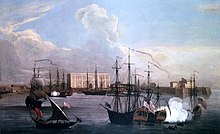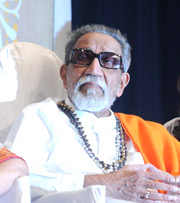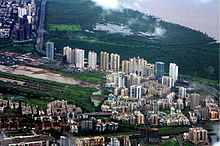History of Bombay in independent India
Background

The

Mumbai was a native Fisherman Land of Marathi Speaking Kolis And Aagris grew into a leading commercial center of
Bombay State

After
In 1947, Congress party activists established the Rashtriya Mazdoor Mill Sangh (RMMS), with a claimed membership of 32,000, to ensure a strong political base in the textile industry. The RMMS served as a lasting impediment to the free development of independent unionism in Bombay.[7] Economic growth in India was relatively strong during much of the 1950s, and employment growth in Bombay was particularly good, as the city's manufacturing sector diversified.[7] The Bombay textile industry until the 1950s was largely homogeneous, dominated by a relatively small number of large industrial mills. From the late 1950s, policies were introduced to curb the expansion of mills and to encourage increased production from the handloom and powerloom sectors, because of their employment generating capacities.[8] Bombay was one of the few industrial centres of India where strong unions grew up, particularly company or enterprise based unions, often in foreign owned firms.[7] A key figure in the Bombay labour movement in the early 1950s, was George Fernandes. He was a central figure in the unionisation of sections of Bombay labour in the 1950s.[8]
Bombay's
Battle of Mumbai
The desire to domesticate a
In the
The States Reorganisation Committee report was to be implemented on 1 November 1956. It caused a great political stir and, led to the establishment of the Samyukta Maharashtra Samiti (United Maharashtra Committee) on 6 February 1956.
The Samyukta Maharashtra Samiti achieved its goal when Bombay State was reorganised on linguistic lines on 1 May 1960.[32] Gujarati-speaking areas of Bombay State were partitioned into the state of Gujarat.[33] Maharashtra State with Mumbai as its capital was formed with the merger of Marathi-speaking areas of Bombay State, eight districts from Central Provinces and Berar, five districts from Hyderabad State, and numerous princely states enclosed between them.[34] In all 105 persons died in the battle for Mumbai.[35] As a memorial to the martyrs of the Samyukta Maharashtra movement, as Hutatma Chowk (Martyr's Square), and a memorial was erected, since it was the starting point of the agitation.[36]
After the 1960 bifurcation, many Gujaratis left Mumbai feeling that they would be better-off in Gujarat than in Mumbai, and fearing that they would be neglected by the Maharashtra Government.[37] The Maharashtrians also blamed the Gujaratis for the death of the 105 martyrs of the Samyukta Maharashtra movement.[15]
Rise of Regionalism

In the 1960s,the Marathi-speaking middle-class in Mumbai, who had been the most consistent supporters of the Samyukta Maharashtra Samiti, felt threatened in Mumbai despite the creation of Maharashtra. This was mainly because of the increasing number of migrants competing with them for jobs.
This was the line taken by Mumbai cartoonist and journalist

The need for urban development on the mainland across from Mumbai Island was first officially recommended in the 1940s. In 1945, a Post-war development committee suggested that areas should be developed on the mainland on the opposite side of the harbour to contain the future growth of the city. In 1947, N. V. Modak and Albert Mayer published their plan, stressing on controlled development of the city, suburbs, and its neighbouring cities like Thane, Vasai, and Uran.[42] In March 1964, the Municipal Corporation of Greater Mumbai submitted its development plan for Greater Mumbai,[43] which was criticized for various reasons,[44] but approved in 1967.[45] By that time, another plan had been developed by two of Mumbai's leading architects Charles Correa and Pravin Mehta, and an engineer Shirish Patel.[45][46] They suggested that a "twin city" of equal size and prominence to Greater Mumbai, would only be able to solve the city's congestion problems. Thus, the idea of the creation of Navi Mumbai was born.[46]
The proposed site for Navi Mumbai covered an area of 344 km2 (133 sq mi), integrating 95 villages spread over the districts of Thane and Raigad.[47]
21st century
During the 21st century, the city suffered several terrorist attacks and natural disasters.
Terrorist attacks
- On 6 December 2002, a bomb placed under a seat of an empty BEST (
- On 27 January 2003, a bomb placed on a bicycle exploded near the Vile Parle station in Mumbai. The bomb killed 1 and injured 25. The blast occurred a day ahead of the visit of Atal Bihari Vajpayee, the then Prime Minister of India to the city.[50]
- On 13 March 2003, a bomb exploded in a train compartment, as the train was entering the 1993 Mumbai bombings.[51]
- On 28 July 2003, a bomb placed under a seat of a BEST bus exploded in Ghatkopar. The bomb killed 4 people and injured 32.[52]
- On 25 August 2003, two blasts in Lashkar-e-Toiba was behind the attacks.[53]
- On 11 July 2006, a series of seven bomb blasts took place over a period of 11 minutes on the Students Islamic Movement of India (SIMI).[57]
November terrorist 2008 attacks
There were a series of
Anti-migrant attacks
In 2008, members of Maharashtra Navnirman Sena (MNS) under Raj Thackeray on attacked North Indian migrants from UP and Bihar and SP Party Workers in Mumbai.[59] Attacks included assault on North Indian taxi drivers and damage of their vehicles.[60]
Natural disasters
Mumbai was lashed by torrential rains on 26–27 July 2005, during which the city was brought to a complete standstill. The city received 37 inches (940 millimeters) of rain in 24 hours — the most any Indian city has ever received in a single day. Around 83 people were killed.[61]
References
- ^ Hansen 2001, p. 38
- ^ a b Hansen 2001, p. 37
- JSTOR 27768789.
- ^ "Bombay: History of a City". British Library. Retrieved 8 November 2008.
- ^ *Census of India, 1961. Vol. 5. Office of the Registrar General (India). 1962. p. 23.
- ^ Alexander, Horace Gundry (1951). New Citizens of India. Indian Branch, Oxford University Press. p. 65.
- ^ a b c Hutchison & Brown 2001, p. 157
- ^ a b Hutchison & Brown 2001, p. 158
- ^ Hansen 2001, p. 39
- Mumbai Suburban District. Archived from the originalon 21 November 2008. Retrieved 6 November 2008.
- Indian Institute of Technology Bombay. Retrieved 13 November 2008.
- Indian Institute of Technology Bombay. Retrieved 13 November 2008.
- ^ a b Sharma 1995, p. 187
- ^ Economic and political weekly. Vol. 15. Sameeksha Trust. 1980. p. 1628.
- ^ a b c Hansen 2001, p. 42
- India after Gandhi. HarperCollins. pp. 197–8.
- ^ Guha, Ramachandra (13 April 2003). "The battle for Bombay". The Hindu. Archived from the original on 14 May 2005. Retrieved 12 November 2008.
{{cite web}}: CS1 maint: unfit URL (link) - ^ Phadke, Y. D. (1981). Senapati Bapat portrait of a revolutionary. Senapati Bapat Centenary Celebration Samiti. p. 86.
- ^ Indian Parliament; House of the People; Lok Sabha (1955). Lok Sabha debates, Part 2, Volume 10. Lok Sabha Secretariat. p. 2858.
- ISBN 978-81-250-0332-8.
- ^ Lok Sabha debates: Appendix, Issues 1-7. Indian Parliament, Lok Sabha. 1955. p. 68.
- ^ Indian Parliament; Lok Sabha (1955). Lok Sabha debates, Part 2, Volume 9. Lok Sabha Secretariat. p. 265.
- ^ Economic and political weekly. Vol. 15. Sameeksha Trust. 1980. p. 1628.
- ^ Bernard, Jean Alphonse (2001). From raj to the republic: a political history of India, 1935-2000. Har Anand Publications. p. 189.
- ^ a b "Samyukta Maharashtra". Government of Maharashtra. Archived from the original on 6 October 2008. Retrieved 12 November 2008.
- ISBN 978-81-7764-856-0.
- ^ Sharma 1995, p. 188
- ^ Sharma 1995, p. 189
- ^ Sharma 1995, p. 190
- ^ Sharma 1995, p. 191
- ^ Sharma 1995, p. 183
- ^ "Sons of soil: born, reborn". Indian Express Newspapers (Mumbai). 6 February 2008. Retrieved on 12 November 2008.
- ^ "Gujarat". Government of India. Archived from the original on 15 January 2008. Retrieved 16 January 2008.
- ^ "Maharashtra". Government of India. Archived from the original on 5 January 2008. Retrieved 16 January 2008.
- ^ Phadke, Y. D. (1979). Politics and language. Himalaya Publishing House. p. 155.
- ^ Desai, Geeta (13 May 2008). "BMC will give jobs to kin of Samyukta Maharashtra martyrs". Mumbai Mirror. Archived from the original on 16 August 2011. Retrieved 16 November 2008.
- ISBN 978-0-86132-067-7.
- ^ Hansen 2001, p. 45
- ^ a b c "Sena fate: From roar to meow". The Times of India. 29 November 2005. Archived from the original on 11 August 2011. Retrieved 12 November 2008.
- ^ Hansen 2001, p. 46
- ^ Hansen 2001, p. 50
- ^ Shaw 2004, p. 63
- ^ Shaw 2004, p. 64
- ^ Shaw 2004, p. 65
- ^ a b Shaw 2004, p. 66
- ^ a b Shaw 2004, p. 67
- ^ "To the Present". Hindustan Times. Archived from the original on 26 March 2008. Retrieved 13 November 2008.
- ^ "Blast outside Ghatkopar station in Mumbai, 2 killed". rediff.com India Limited. 6 December 2002. Retrieved 19 August 2008.
- ^ "1992: Mob rips apart mosque in Ayodhya". BBC. 6 December 1992. Retrieved 11 November 2008.
- ^ "1 killed, 25 hurt in Vile Parle blast". The Times of India. 28 January 2003. Archived from the original on 22 October 2012. Retrieved 19 August 2008.
- ^ "Fear after Bombay train blast". BBC. 14 March 2003. Retrieved 19 August 2008.
- ^ Vijay Singh; Syed Firdaus Ashra (29 July 2003). "Blast in Ghatkopar in Mumbai, 4 killed and 32 injured". rediff.com India Limited. Retrieved 19 August 2008.
- ^ "2003: Bombay rocked by twin car bombs". BBC. 25 August 2003. Retrieved 19 August 2008.
- ^ "At least 174 killed in Indian train blasts". CNN. 11 July 2006. Retrieved 11 November 2008.
- ^ "India: A major terror target". The Times of India. 30 October 2008. Retrieved 11 November 2008.
- ^ "Rs 50, 000 not enough for injured". Indian Express Newspapers (Mumbai) Ltd. 21 July 2006. Archived from the original on 14 January 2009. Retrieved 11 November 2008.
- ^ "India police: Pakistan spy agency behind Mumbai bombings". CNN. 1 October 2006. Retrieved 11 November 2008.
- ^ "HM announces measures to enhance security" (Press release). Press Information Bureau (Government of India). 11 December 2008. Retrieved 14 December 2008.
- Daily News & Analysis. 16 February 2008. Archived from the originalon 3 June 2008. Retrieved 19 August 2008.
- ^ "North Indian taxi drivers attacked in Mumbai". NDTV. 29 March 2008. Archived from the original on 2 June 2008. Retrieved 19 August 2008.
- ^ "Maharashtra monsoon 'kills 200'". BBC. 25 July 2005. Retrieved 17 August 2008.
Bibliography
- Hansen, Thomas Blom (2001). Wages of violence: naming and identity in postcolonial Bombay. Princeton University Press. ISBN 978-0-691-08840-2.
- Hutchison, Jane; Brown, Andrew (2001). Organising labour in globalising Asia (illustrated ed.). Routledge. ISBN 978-0-415-25060-3.
- Sharma, Sadhna (1995). States politics in India. Mittal Publications. ISBN 978-81-7099-619-4.
- Shaw, Annapurna (2004). The Making of Navi Mumbai. Orient Blackswan. ISBN 978-81-250-2600-6.
